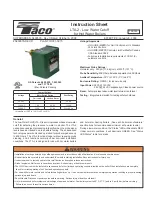
1. Installation Requirements - Page 8
1.1
General Information
Both the user and the manufacturer rely heavily on the
installer, whose job it is to install the combination boiler, and
connect it to a correctly designed heating system. Acquaint
yourself with the British Standards concerning installation
requirements. If you need advice on any points, Potterton's
Service Operations will be pleased to help (see back page).
It is recommended that tools suitable for brass fittings are
used, and have a capability to accommodate hexagon sizes
up to 50mm.
Codes Of Practice
I.E.E Regulations
Model Water Bye Laws
Building Regulations/Building Standards for Scotland.
Health and Safety Document No.635. (The Electricity at
Work Regulations 1989)
BS. 6891
Installation of low pressure pipes.
BS. 6798
Installation of gas boilers of rated input not
exceeding 60kW.
BS. 5449
Forced circulation hot water C.H. systems.
Including smallbore and microbore domestic
central heating systems.
BS. 5546
Installation of gas hot water supplies for
domestic purposes.
BS. 5440:1 Flues (for gas appliances of rated input not
exceeding 60 kW).
BS. 5440:2 Air supply (for gas appliances of rated input not
exceeding 60 kW).
BG. DM2
Guide for gas installation in timber framed
buildings.
It is important that no external control devices e.g. flue
dampers, economisers etc., be directly connected to this
appliance unless covered by these Installation and Service
instructions or otherwise recommended by Potterton in
writing. If in doubt please enquire.
Any direct connection of a control device not recommended
by Potterton could invalidate the certificate and the normal
appliance warranty and could also infringe the Gas Safety
Regulations.
Manufacturers instructions must not be taken in any way as
over-riding statutory obligations.
Gas Supply
The local Gas Region should be consulted, at the installation
planning stage, in order to establish the availability of an
adequate supply of gas.
An existing service pipe must NOT be used without prior
consultation with the Local Gas Region.
A gas meter can only be connected by the Local Gas
Region, or by a Local Gas Region Contractor.
An existing meter should be checked, preferably by the Gas
Region, to ensure the meter is adequate to deal with the rate
of gas supply required.
Installation pipes should be fitted in accordance with BS
6891.
Pipework from the meter to the combination boiler must be
of an adequate size.
Do NOT use pipes of a smaller size than the combination
boiler inlet gas connection (15mm).
The complete installation must be tested for gas soundness
and purged as described in BS 6891.
Health and Safety Information for the
Installer and Service Engineer
Under the Consumer Protection Act 1987 and Section 6 of
the Health and Safety at Work Act 1974, we are required to
provide information on substances hazardous to health.
Small quantities of adhesives and sealants used in the
product are cured and present no known hazards.
The following substances are also present.
Insulation and Seals
Material
- Ceramic Fibre. Alumino - Silicone Fibre.
Description
- Boards, Ropes, Gaskets.
Known Hazards
- Some people can suffer reddening and
itching of the skin. Fibre entry into the eye will cause foreign
body irritation. Irritation to respiratory tract.
Precautions - People with a history of skin complaints may
be particularly susceptible to irritation. High dust levels are
only likely to arise following harsh abrasion.
In general, normal handling and use will not present
discomfort, follow good hygiene practices, wash hands
before consuming food, drinking or using the toilet.
First Aid - Medical attention must be sought following eye
contact or prolonged reddening of the skin.
Heat Exchanger
Material
- Copper with lead/tin coating.
Description
- Finned copper tube.
Known Hazards
- Inhalation or ingestion of lead dust or
fumes may cause headache and nausea.
Precautions
- Unused heat exchangers present minimal risk
to health other than normal hygiene practices would demand
regarding washing before eating etc. Deposits found on or
below a heat exchanger that has been in use could contain
lead oxide. Avoid inhalation by using a vacuum cleaner in
conjunction with other cleaning tools when servicing the
appliance.
Summary of Contents for 80e
Page 5: ...Optional Extras Page 5 ...
Page 6: ...Optional Extras Page 6 Installation instructions included as necessary with each kit ...
Page 7: ...Optional Extras Page 7 Installation instructions included as necessary with each kit ...
Page 12: ......
Page 28: ...Routine Maintenance Page 27 ...
Page 30: ...Routine Maintenance Page 29 ...
Page 34: ...Component Replacement Page 33 ...
Page 35: ...Component Replacement Page 34 ...
Page 43: ...7 1 Control Flow Sequence Permanent Pilot Page 42 ...
Page 44: ...7 2 Functional Flow Permanent Pilot Page 43 ...
Page 45: ...7 3 Fault Finding Permanent Pilot Page 44 ...
Page 46: ...7 4 Electrical Diagram Permanent Pilot Page 45 ...
Page 47: ...8 1 Control Flow Sequence Electronic Page 46 ...
Page 48: ...8 2 Functional Flow Electronic Page 47 ...
Page 49: ...8 3 Fault Finding Electronic Page 48 ...
Page 50: ...8 4 Electrical Diagram Electronic Page 49 ...









































